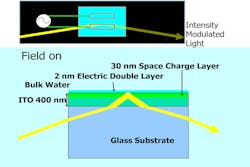Scientists at the Tokyo University of Science have come up with a novel method of modulating light using water as a medium.1 They say that the method is inexpensive and more efficient than existing ones, potentially leading to new, improved optical devices.
One property used for light modulation, the Pockels effect, is seen when an electric field is applied to the medium through which light travels. Under the Pockels effect, the refractive index of the medium changes proportionally to the applied electric field. Exactly how this effect occurs in different materials is not very clear yet, making it difficult to fully explore its potential.
Interfacial Pockels effect
The team of scientists, led by Prof Eiji Tokunaga at the Tokyo University of Science and including Daisuke Hayama, Keisuke Seto, Kyohei Yamashita, Shunpei Yukita (all Tokyo University of Science), and Takayoshi Kobayashi (The University of Electro-Communications and National Chiao-Tung University), shed light on the mechanism of the Pockels effect in a new type of light modulator. Until recently, this effect had been observed only in certain crystals (such as KD*P and BBO) that are costly to use.
Twelve years ago, Tokunaga and his team observed this effect for the first time in the top layer (also called the interfacial layer) of water (and not seen in the bulk of water) when it is in contact with an electrode. Although the Pockels coefficient was an order of magnitude greater, it turned out that because this effect was generated only in the thin interfacial layer, this called for a highly sensitive detector. And even its mechanism was not clearly understood, further complicating the process.
To find a solution, the scientists created a setup with a transparent electrode on a glass surface in water, and an electric field was applied to it. The interfacial layer (also called the electric double layer or EDL) is only a few nanometers thick and shows different electrochemical properties than the rest of the water. It is also the only part of water where the Pockels effect can be observed under an electric field. The scientists used the total internal reflection to create a large angle at the interface between water and electrode. They observed that when light travels through the electrode and enters the EDL, changes in the refractive index of both layers can modify the reflected signal.
Because the refractive index in the transparent electrode is larger than for both water and glass (1.33 and 1.52, respectively), the amount of light reflected at both ends increases, causing a more enhanced Pockels effect. This was important because an enhanced signal would mean that even low-sensitivity devices could be used to measure it. Also, because the experimental setup is not complex, consisting of only a transparent electrode dipped in water containing electrolytes, this method is much simpler and less expensive to use. “Through our technique, we observed light modulation with a maximum intensity change of 50% proportional to the applied AC voltage,” says Tokunaga.
The theoretical calculations matched with the experimental results; moreover, theoretically, a 100% light intensity modulation could be achieved.
Source: Tokyo University of Science
REFERENCE:
1. Daisuke Hayama et al., OSA Continuum (2019); https://www.doi.org/10.1364/OSAC.2.003358.

John Wallace | Senior Technical Editor (1998-2022)
John Wallace was with Laser Focus World for nearly 25 years, retiring in late June 2022. He obtained a bachelor's degree in mechanical engineering and physics at Rutgers University and a master's in optical engineering at the University of Rochester. Before becoming an editor, John worked as an engineer at RCA, Exxon, Eastman Kodak, and GCA Corporation.
